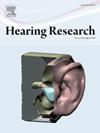The relationship between auditory brainstem responses, cognitive ability, and speech-in-noise perception among young adults with normal hearing thresholds
IF 2.5
2区 医学
Q1 AUDIOLOGY & SPEECH-LANGUAGE PATHOLOGY
引用次数: 0
Abstract
The goal of this research was to determine the contributions of auditory neural processing and cognitive abilities to predict performance on a speech-in-noise perception task in young, normal hearing adults. Two experiments were performed, each with separate cohorts of ∼30 young adults with normal hearing who performed a competing talker task which included a high-pass filtered condition that was designed to be more sensitive to auditory nerve functioning than are commonly used speech-in-noise perception tests. Predictors of performance on this competing talker task included ABR waves I and V metrics and cognitive test scores. Experiment one included click ABRs at a moderate level commensurate with the level of the competing talker task, as well as the cognitive digit span working memory test. Experiment two included high-intensity click clinical ABRs and three cognitive tests from the NIH Toolbox V3 that assessed working memory, cognitive flexibility and attention, and inhibitory control: List Sorting Working Memory, Dimensional Change Card Sort, and Flanker Inhibitory Control and Attention tests, respectively. Performance on the high-pass filtered competing talker task varied across participants in both experiments. This variability was predicted by performance on the test of inhibitory control, but not the tests involving working memory or cognitive flexibility, nor by any of the auditory processing metrics from moderate or high-intensity click ABRs. Among two groups of young adults with normal hearing, cognitive factors with very similar demands to the competing talker task seem to play the greatest role in speech-in-noise perception.
听力阈值正常的年轻人的听觉脑干反应、认知能力和噪音中言语感知的关系
本研究的目的是确定听觉神经处理和认知能力的贡献,以预测年轻、听力正常的成年人在噪音中语音感知任务中的表现。进行了两个实验,每个实验由30名听力正常的年轻成年人组成,他们执行了一个竞争性的说话者任务,其中包括一个高通滤波条件,该条件被设计成对听觉神经功能比常用的语音噪声感知测试更敏感。在这个竞争性谈话者任务中的表现预测指标包括ABR波I和V指标以及认知测试分数。实验一包括与竞争性说话者任务水平相称的中等水平的点击abr,以及认知数字广度工作记忆测试。实验二包括高强度点击临床abr和来自NIH工具箱V3的三个评估工作记忆、认知灵活性和注意力以及抑制控制的认知测试:列表排序工作记忆、维度变化卡片排序和侧卫抑制控制和注意力测试。在两个实验中,参与者在高通滤波竞争谈话任务上的表现各不相同。这种可变性可以通过抑制控制测试的表现来预测,但不能通过涉及工作记忆或认知灵活性的测试来预测,也不能通过任何来自中等或高强度点击abr的听觉处理指标来预测。在两组听力正常的年轻人中,与竞争性说话者任务要求非常相似的认知因素似乎在噪音中的言语感知中发挥了最大的作用。
本文章由计算机程序翻译,如有差异,请以英文原文为准。
求助全文
约1分钟内获得全文
求助全文
来源期刊

Hearing Research
医学-耳鼻喉科学
CiteScore
5.30
自引率
14.30%
发文量
163
审稿时长
75 days
期刊介绍:
The aim of the journal is to provide a forum for papers concerned with basic peripheral and central auditory mechanisms. Emphasis is on experimental and clinical studies, but theoretical and methodological papers will also be considered. The journal publishes original research papers, review and mini- review articles, rapid communications, method/protocol and perspective articles.
Papers submitted should deal with auditory anatomy, physiology, psychophysics, imaging, modeling and behavioural studies in animals and humans, as well as hearing aids and cochlear implants. Papers dealing with the vestibular system are also considered for publication. Papers on comparative aspects of hearing and on effects of drugs and environmental contaminants on hearing function will also be considered. Clinical papers will be accepted when they contribute to the understanding of normal and pathological hearing functions.
 求助内容:
求助内容: 应助结果提醒方式:
应助结果提醒方式:


